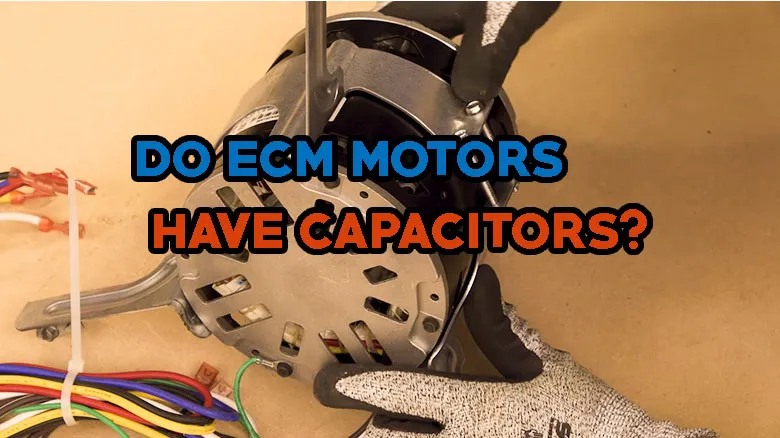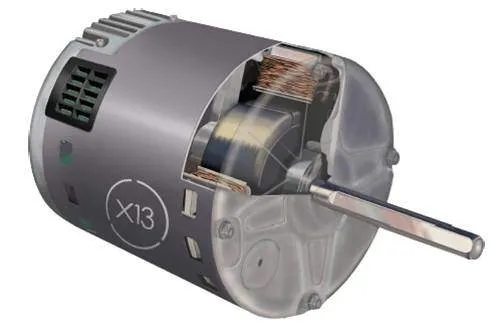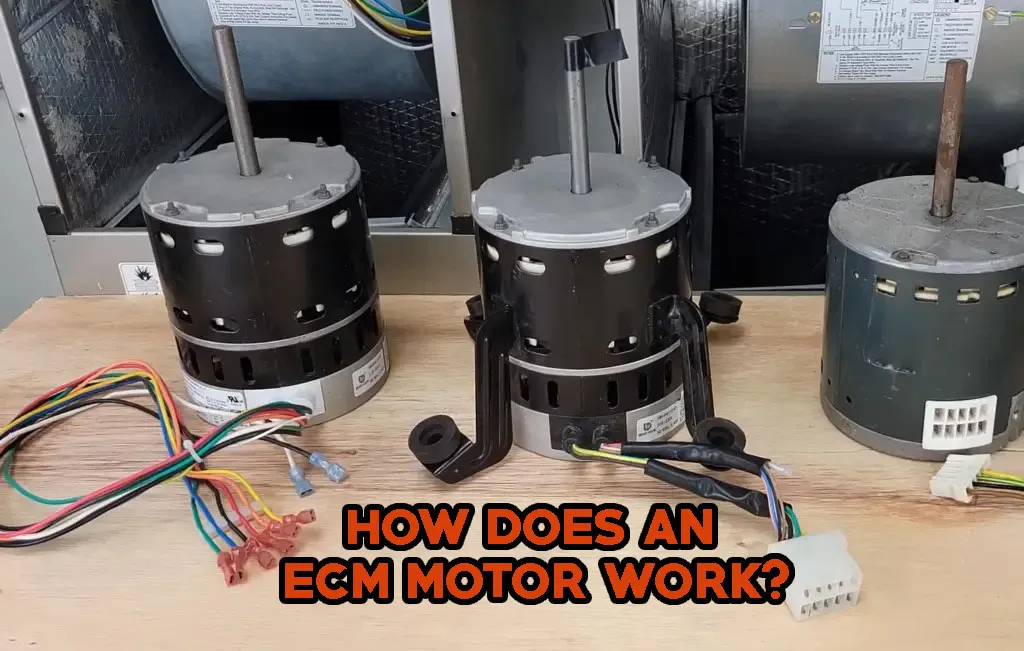Do ECM Motors Have Capacitors?

Do ECM Motors have Capacitors
Energy efficiency and advanced control capabilities have made Electronically Commutated Motors (ECM) extremely popular. Using advanced electronic control systems, these motors can be adapted to meet the demands of a variety of loads by regulating speed, torque, and other parameters.
The question of whether ECM motors have capacitors often arises when studying the inner workings of ECM motors. In this article, we will explain Do ECM Motors have Capacitors or not. The article also explores the function, design, and interactions of capacitors in ECM motors and their role in their operation.
What Is an ECM Motor?

What is an ECM Motor?
The term "Electrically Commutated Motors" describes a motor using electronic control to change speed. A constant CFM motor, constant RPM motor, and a constant torque motor are three types of ECM motors. The basic principles of CFM, RPM, and torque are the same since they are all related. The Constant Torque ECM Motor will be the subject of my discussion for ease of understanding.
Those devices that provide heat or cool to an area are known as HVAC devices. A climate-controlled building or a large office is especially in need of these considerations. Identifying ways to improve the efficiency of machines is a primary objective of current HVAC research.
Homeowners & businesses can also benefit from energy savings because they save money and are good for the environment. Air conditioners and furnaces benefit from ECM engines, also known as variable-speed motors. A converter motor, or ECM motor, helps ensure that adequate airflow is maintained through an AC or furnace while reducing overall power consumption.
ECM motors do not only save energy, but also provide several other benefits. They have a longer lifespan, operate quietly, and produce less heat. Improved air quality, reduced noise levels, and improved comfort are all possible with precise speed control. The ECM motor also contributes to a cleaner environment by minimizing greenhouse gas emissions.
Do ECM Motors Have Capacitors?
The electronic controlled motor, or ECM, makes motors more efficient and functional while reducing energy consumption. Often referred to as PSC motors, permanent split capacitor motors deliver power through non-polarized capacitors and brushes.
This type of brush has a short lifespan due to its tendency to degrade over time. The lack of brushes on ECM motors allows them to last longer and require less maintenance. A furnace or air conditioner uses less electricity when it is properly cooled and maintained.
How Does an ECM Motor Work?

How Does an ECM Motor Work?
Electromagnets inside its stator are energized by an electromagnet inside the stator. Microprocessors are the key component that makes ECM motors able to provide higher efficiency, since their artificial intelligence system is based on them. Microprocessors are able to detect torque changes and increase the motor's speed accordingly. CFM is maintained at the programmed level by increasing speed to create more airflow.
Also, ECM control pulses the DC voltage to drive three-phase motors according to the AC single-phase power. Energy-efficient ECM motors consume less electricity than traditional motors.
Types Of Electronically Commutated Motors (ECM)
Constant Speed ECMs
As system resistance changes, constant speed ECMs keep their speed constant. A constant speed is crucial for some types of fans and blowers, so these motors are commonly used in these applications. By maintaining a constant rotational speed, constant speed ECMs can precisely control and optimize the performance of the system.
Constant Airflow ECMs
In spite of changes in system resistance, Constant Airflow ECMs maintain constant airflow. HVAC systems, which require a constant flow of air to perform efficiently, commonly use these motors. The Continuous Airflow ECM's speed and torque are adjusted as the system pressure changes in order to maintain a steady airflow.
Constant Torque ECMs
ECMs with constant torque should maintain torque regardless of the system resistance in a number of applications. Conveyors and pumps, for example, rely on these motors to maintain a constant torque. It ensures reliable performance under varying loads thanks to constant torque ECMs.
How do ECM motors typically fail?
Electrical Surges
Electric surges can damage electronic components, including ECM motors, as they cause sudden increases in electrical voltage. Various factors can cause surges, such as lighting strikes, fluctuations in the grid, and faulty wiring. Because of their complex control electronics, ECM motors are especially vulnerable to electrical surges. The risk of electrical surges damaging ECM motors can be mitigated with surge protection devices such as surge suppressors and voltage regulators.
Overheating
ECM motor failures are often caused by overheating. Increasing operating temperatures result in motors losing their efficiency and prematurely failing due to the degrading of insulation, lubrication, and electronic components. Overheating occurs when a motor is operated too hot, has inadequate ventilation, or has blocked airflow. Overheating-related failures can be prevented by regular inspections of cooling systems and proper ventilation.
Electronic Component Failure
Power electronics, microcontrollers, and sensors all play a role in controlling ECM motors. Manufacturing defects, aging, electrical stresses, and environmental factors all can cause the failure of these components. Motors can malfunction, lose control, or shut down completely due to electronic component failure. Detecting and addressing potential issues with electronic components early can help prevent motor failures through proper handling, regular maintenance, and monitoring.
Use of Blower
HVAC systems typically use ECM motors to drive blowers. ECM motor performance and reliability can be affected by the blower assembly. When a blower is not installed or maintained properly, excessive load can be placed on the motor, the blower may be misaligned, or air flow may be restricted. ECM motors can be prematurely damaged because of these factors;
Moisture:
ECM motors are susceptible to moisture damage. Water and excessive moisture can cause corrosion, short circuits, and insulation breakdowns on motors. The motor can be saturated by moisture when the environment is humid. ECM motors can be protected from moisture damage with proper sealing, insulation, and maintenance;
Bearing Failure
ECM motors operate smoothly thanks to bearings. Continuous use, lack of lubrication, or contamination can cause bearings to wear out over time. Motor imbalance and friction can be caused by bearing failures. Bearing-related failures can be prevented by regularly lubricating, monitoring, and replacing bearings in time.
Faqs
Question 1: ECM motors are composed of what?
Answer: Motors with electronic commutation are brushless DC motors that operate on three phases. Three main components make up the unit: a controller, a rotor with a permanent magnet, and a circuit board.
Question 2: How efficient are ECM motors?
Answer: A traditional motor is less efficient than an ECM motor. Variable speed capabilities and advanced control algorithms make ECM motors ideal for optimizing efficiency. They can reduce energy consumption and operating costs by adjusting speed, torque, and air flow based on real-time needs. ECM motors are highly efficient in a variety of applications due to their ability to match their output to the load requirements.
Question 3: Is a capacitor present in every electric motor?
Answer: Sadly, no. Capacitors are usually included in larger electric motors to provide extra current. The rated current can be easily reached once it is running. A capacitor is not required for smaller motors, since they don't require extra power to start.
Question 4: Do ECM motors have windings?
Answer: There are windings on ECM motors. Magnetic fields are created by multiple windings in the stator of an ECM motor. As far as winding configuration and control mechanisms go, ECM motors are different from traditional motors. Motors with ECM control systems operate at variable speeds and can be controlled precisely instead of using a single set of windings.
Question 5: Are ECM motors DC or AC?
Answer: The ECM motor is normally an AC (Alternating Current) motor. The standard AC power supply is used to power them in homes, businesses, and industries. As a result, ECM motors are able to operate with variable speed control and enhanced efficiency by using advanced electronic control systems.
Final Verdict
According to a number of specifications, ECMs are meant to moderate PSC motors. ECM does not need a capacitor as per PSC, but it is essential for its operation. Depending on your purpose, you will need a different type of motor. Consequently, determine the purpose of the ECM and then manage it properly.
Furthermore, I hope after reading our article which is about Do ECM motors have capacitors, all your confusion will be cleared! If you still have any questions, then you can ask in the comment section. We’d love to help you all the time. Thank You!
Rlated Articles
Do ECM Motors Have Capacitors?
How Does a Single Phase Motor Work?
What is an Electric Motor? Explain its Types
Servo Motor vs. Stepper Motor: Key Differences Explained
Capacitor vs Resistor: What's the Differences?
Do Capacitors Get Hot? [All You Know]
Film vs Ceramic Capacitor: What's the Differences?
How Long Do Electrolytic Capacitors Last [Explained]
How to Charge Capacitor Without Resistor?
How to Dispose of Capacitors?
How to Install a Capacitor to Two Amps
How to Test a Hard Start Capacitor [Complete Guide]










